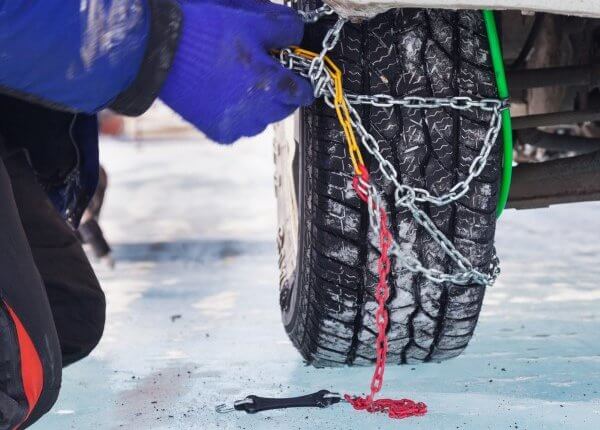- Now Hiring! →
- Technician/Mechanic
 303-825-5700
303-825-5700 service@paddockimports.com
service@paddockimports.com- call now
Chains and Tire Damage
 February 13, 2020
February 13, 2020

Guide: Using Chains On Tires For Snow
Paddock Imports knows all about tire repair. If you live in Denver, you are familiar with how much snow you’ll have to deal with each year. If you are new to the area or if you are visiting, there are a few things you should know about using chains if you want to prevent tire damage. Before you do anything, be sure to check local laws regarding tire chains in Denver. Even if you are driving a rental, the laws regarding snow tires or chains still apply.
Get the Right Size
Before buying tire chains, you’ll need to know the width and right size to buy. To get the numbers you’ll need from your tires:
- Locate the numbers on the sidewall of the tire
- The first three consecutive numbers represent the width of the tire in millimeters
- The two digits between the dash and the R are the ratio of width to height
- The two numbers immediately after the R indicate the tire size
If you write down the results of steps 2-4 with a slash between them, you’ll have the measurements necessary to order tire chains to keep you safe in hazardous driving conditions around Denver.
Practice Installing Them
Once you have the right size chains for your vehicle, the first thing to do is to learn the steps to install them. The last thing you want to do is to find out you don’t know how to put the chains on when it is cold and snowy on the road in the middle of nowhere. Read and understand the instructions. Then, get in a flat dry space like your driveway, and practice putting them on until you are confident you can do it when the need is there.
Get a Partner
Make your life easier by having a partner help while installing the chains. When you have the chains partially on the tire, have your assistant pull the vehicle forward slowly to finish putting the chains on. Adjust and tighten until they are secure.
Know How Many To Use
Though it is ideal to use chains on all four tires on two-wheel-drive vehicles, you must attach the chains to the wheels on the drive axle. There are considerations for only using two tire chains, as the front will cause a tendency to oversteer, and the back only will create a tendency to understeer. On four-wheel-drive cars or trucks, you must put chains on each tire.
Assess the Conditions
Just because the chances of snow or ice are high, it doesn’t mean you can go ahead and put your tire chains on. Some conditions must exist before using tire chains. Make sure that the ice and snow are reasonably deep before you attempt to drive with chains. If you are driving into the snow, pull off of the road where you have plenty of room to install them safely. It’s a good idea to keep gloves and something to kneel on like a tarp or waterproof mat in your vehicle for when you need them.
Fix Loose or Broken Chains Quickly
To prevent tire repair, pay attention to your chains while driving. If the chain becomes loose or breaks, stop immediately. Not only will it defeat the purpose of having the chains with the loss of the added traction, but it could do much more than tire damage, particularly if it causes an accident.
Modify Your Driving
When driving with snow chains, you have to modify your driving habits from how you would usually drive. Accelerate slowly and steadily, with no sudden surges. Keep your speed at or under 30 mph. Make sure to brake carefully without slamming on brakes and for watch curbs or obstacles.
Contact Paddock Imports Today!
When you need a trusted professional for wheel or tire service in Denver, CO Paddock Imports are the experts. Contact Paddock Imports today or call 720-893-8038 for more information on their wheel and tire services.
Photo Credit: Shutterstock / By Siberia Video and Photo
